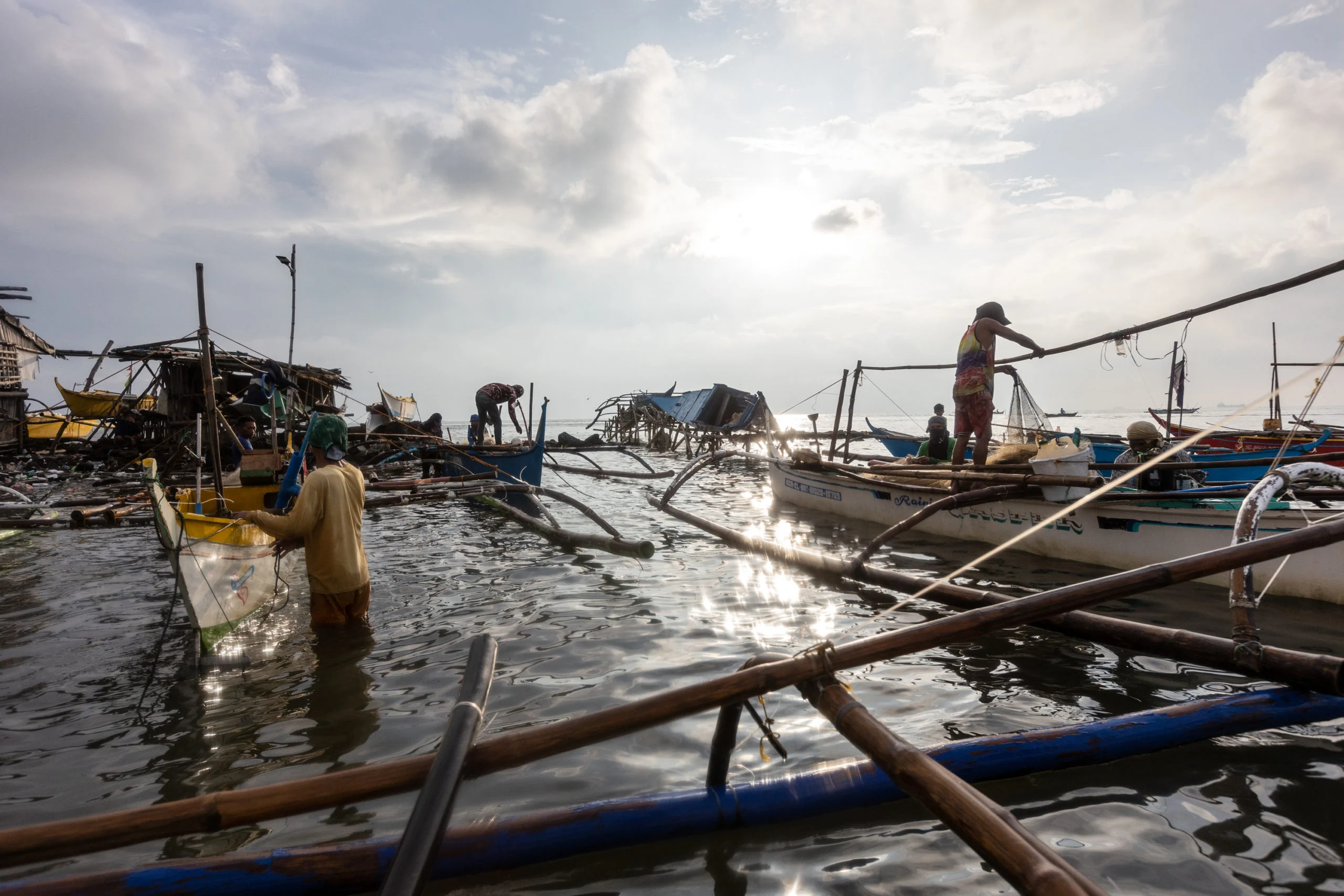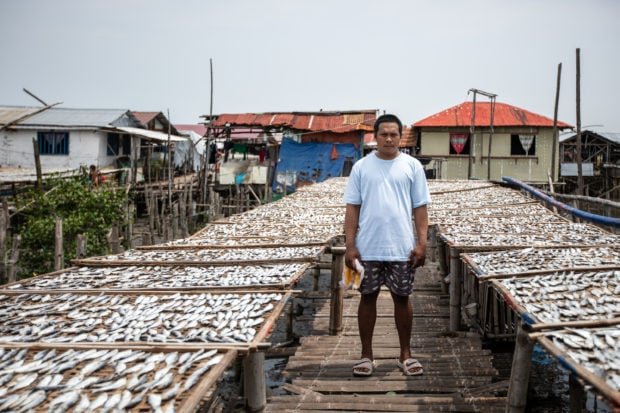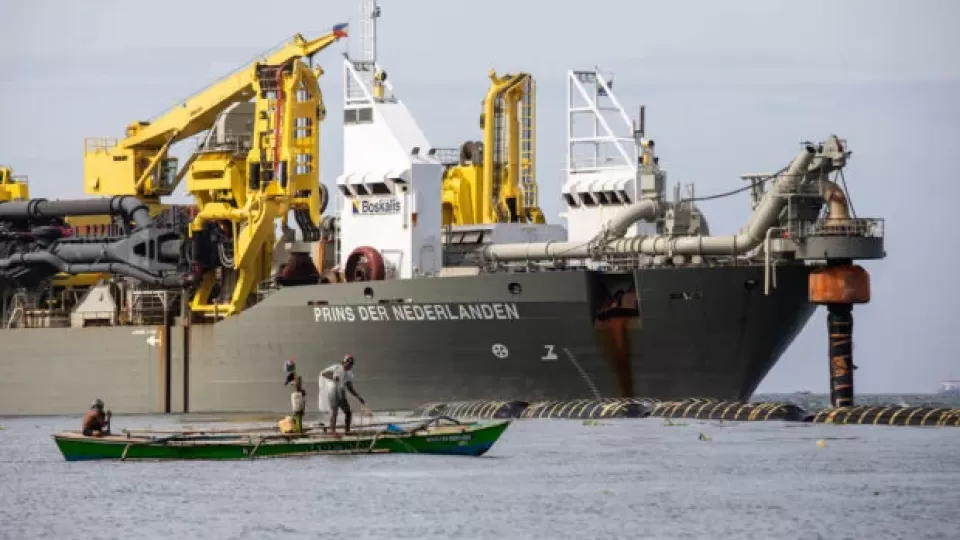February 2, 2023
MANILA — Before daybreak, Edwin Rosales, 33, would set out for Manila Bay to find the best spots to cast his net for “alubaybay,” a variety of sardines and a major income-earner in his coastal village in Limay, Bataan province, a supplier of “tuyo” (dried fish) for markets in Metro Manila.
Having learned the ways of the sea from his father and grandfather, Rosales remembered a time when he didn’t have to go far in his motorboat for a good catch within Limay’s local waters. But in recent years he had been forced to venture farther out to Bulacan or Cavite provinces, with the haul getting smaller and paying little for the extra effort.
He and other longtime fishermen in the village agreed that the dwindling yield may be due to overfishing. But recently another, more disturbing factor emerged.
In Cavite, a number of large vessels had entered the old fishing grounds, dredging the seafloor and filling their bellies with wet sand, before sailing off and leaving a wrecked marine ecosystem in their wake.
On at least two occasions, Rosales said, the dredgers “ran over my net because I couldn’t get out of their way fast enough.”
‘Evil twins’
“Before they arrived, we were free to fish there. The sadder part was that they chose the spots that were known to be hatching grounds,” he added. “Now that they have mined those areas, we think the fish have left.’’
Fisherfolk and environmental advocates blamed Rosales’ plight on what they considered the “evil twins” now doing damage on Manila Bay away from public gaze: quarrying and reclamations.
They noted an increase in seabed mining activities — or the extraction of mud, silt, and sand from the seafloor — since April 2021 after then President Rodrigo Duterte lifted the nine-year moratorium on mineral agreements, undoing Executive Order No. 79 that was issued during the Benigno Aquino III presidency.
According to the Environmental Management Bureau (EMB), dredging operations in various areas of the bay currently cover about 13,530 hectares.
The EMB confirmed two ongoing operations in the bay, both in the coastal waters of Cavite: the San Nicolas Shoal Seabed Quarry Project of VIL Mines Inc. (active since 2022 and covering some 8,530 ha), and the Seabed Quarry Project of the Philippine Reclamation Authority (beginning in 2021 and covering 5,000 ha).
Crowded out
In Limay, Bataan, Cargon Mining Corp. applied for a permit in 2020 to extract some 77 million tons of sand, according to the bureau.
The following year, however, the Bureau of Fisheries and Aquatic Resources (BFAR) denied Cargon’s application for area clearance, as well as that of 12 other companies. In rejecting them, the bureau said it “cannot simply dismiss the potential adverse impacts of seabed quarrying on fisheries.”
“Further degradation [of] fisheries habitats in Manila Bay and the rest of our fishing grounds will surely result in depletion in fisheries biodiversity,” the BFAR explained.
Aware of the BFAR rejections, Rosales and his colleagues were thus puzzled by the continued presence of dredgers in the bay.
They were not being “territorial,” he said. “We share our area and we don’t bar others from coming here; as long as you are a fisherman you can partake of what the sea can offer.”
“But because of the quarrying, the reclamations, it’s getting crowded here… So many businesses are crowding us out of the bay,’’ said Rosales, who heads the local chapter of the fisherfolk group Pangisda.

A DAY IN A LIFE Every day, the fisherfolk of Bataan province set out to sea in the Manila Bay to survive. Lately, however, seabed quarrying and reclamation activities have shrunk their fishing grounds. – PHOTOS BY KATHLEEN LEI LIMAYO
Read more: https://newsinfo.inquirer.net/1722725/seabed-quarrying-crowding-us-out-say-manila-bay-fisherfolk#ixzz7s8zQPinD
Follow us: @inquirerdotnet on Twitter | inquirerdotnet on Facebook
Minimizing impact
In an email interview last week, then EMB Director William Cunado said the agency allowed the quarrying operations of VIL Mines and the PRA since they had complied with the requirement to introduce “mitigating measures,” like the installation of silt curtains and oil spill arresters to control pollution, and the establishment of buffer zones along the coastline and nearshore seabeds.
According to the environmental impact statements (EIS) submitted by the VIL and PRA to the EMB, the filling materials extracted by both operations were intended for government reclamation projects, including the 265-ha Pasay Reclamation Project near the SM Mall of Asia complex and the new international airport planned in Taliptip, Bulacan.
In its EIS, a copy of which was obtained by the Inquirer, VIL Mines also promised to keep off valuable fishing grounds and implement “social development and management plans” to provide alternative sources of livelihood for any displaced fishermen.
The company also said it would set aside P115 million to fund livelihood, educational and health programs for the affected coastal communities.

‘MANILA BAY ISLAND’ Earth-moving equipment is seen atop this mound of sand in front of the Philippine Senate, actually a reclamation project by the Pasay city government. – PHOTOS BY KATHLEEN LEI LIMAYO
Read more: https://newsinfo.inquirer.net/1722725/seabed-quarrying-crowding-us-out-say-manila-bay-fisherfolk#ixzz7s8zdLf7w
Follow us: @inquirerdotnet on Twitter | inquirerdotnet on Facebook
No replacement
But for the fisherfolk of Limay, those promised programs offered little assurance and could not supplant their way of life.
Angelo Dula, 39, said he could no longer go to some of his usual fishing areas near Malabon City, Cavite and Bulacan since the quarrying started. Many of those areas, he said, were known hatching grounds for sardines and threadfin bream (“bisugo”).
Like Rosales, Dula said he had encountered the dredging vessels up close when they dislodged his nets and laid his day’s work to waste. (Most Limay fishermen use gillnets, locally known as “panyo,” which cost around P6,000 per set.)
“They would just run over our nets like they own the sea; they don’t care at all,” he said. “They don’t even try to avoid them.”
Elpidio dela Cruz, another local fisherman, said the disturbed sediment could cling to their nets “like snot and it’s not easy to remove.”

HARDSHIPS Angelo Dula, a fisherman from Limay, has been fishing on Manila Bay since he was 14. Where before a single journey could earn them P800, now two trips can get them enough fish only to earn at least P400. –PHOTOS BY KATHLEEN LEI LIMAYO
Risk of red tide
Quarrying basically leaves the seafloor too muddy for fish to stay, said Fernando Siringan, a marine scientist from the University of the Philippines-Marine Science Institute (UPMSI).
Scooping out the sand could also release “dormant cysts of red tide species” that were already embedded harmlessly in the seabed, he said. In the right conditions, the cysts could reproduce and repopulate the water surface, causing algal blooms that are toxic to marine life.
“These are the kinds of considerations that should have been measured and weighed against the benefits of scraping the seabed,” Siringan said. “Because the consequences would not just affect the communities in offshore Bataan but everybody using Manila Bay.”
Gloria Estenzo-Ramos, vice president of the marine conservationist group Oceana Philippines, added: “We know that if you do seabed quarrying, you’re destroying what’s there. There should be transparency but we’re not seeing any of that.”
Since the 1970s
But the worst effects of seabed mining may be too subtle or incremental to be immediately seen and felt.
Siringan said the coastal erosion currently taking place in Cavite may be traceable to seabed mining in San Nicolas dating back to the 1970s. A UPMSI study touching on this correlation is in progress.
Materials obtained from quarrying activities during the period were used for reclamation projects covering wide swathes of Manila Bay, including areas that now host the Manila Film Center, the Folk Arts Theater and the Rizal Park, among others, he said.
Communities near reclaimed or quarried areas should be aware that as the water becomes deeper because of the extractions, waves can penetrate coastlines with their ‘’full energy,’’ making the local population more vulnerable to the impact of typhoons, which are then amplified by climate change, he added.

BAY’S BOUNTY Fisherman Angelo Dula of Limay, Bataan province, is among those depending on Manila Bay for their livelihood. Photo by: KATHLEEN LEI LIMAYO/CONTRIBUTOR
Local officials have been telling Edlyn Rosales that Manila Bay is already a dead body of water.
Friends who otherwise meant well have told her the same, she said.
But as for barangay officials who compared the 58-kilometer-wide bay “to a sewer where you can only get mud,” it dawned on Rosales finally that her family and their community were being persuaded to leave their home.
Their huts are perched on stilts and bamboo bridges on the coast of Limay town in Bataan, the province west of the bay opposite Bulacan province, Metro Manila, and Cavite province.
“Manila Bay is not a sewer,” Rosales insisted. “They’ve been telling us that Manila Bay is dead, but that is not true. We can still fish from its waters.”
In this fisherfolk community, it was her task to sift through her husband and brother’s catch — mostly “alubaybay,” a sardine variety. She would place the fish in neat rows on bamboo mats, then salt and dry them in the sun, until they are ready to be packed and sold.
With that catch, how could Manila Bay be dead?

PROOF OF LIFE Around a hundred fisherfolk live in one community alone in Limay, Bataan. Rows and rows of tuyo are lined up on their bamboo bridges. Among them is Edlyn Rosales, a longtime manunuyo. Photos by: KATHLEEN LEI LIMAYO
DENR order
Environment activists supporting the fisherfolk in Limay want the government to do a thorough study of Manila Bay’s ecosystem before green-lighting dump-and-fills and seabed quarrying projects that are now overcrowding the bay.
These activities, they said, are reversing the ongoing rehabilitation efforts there.
Seabed quarrying, however, is permitted by Administrative Order No. 2000-25 of the Department of Environment and Natural Resources (DENR).
The 2000 order authorizes the “utilization of offshore areas not covered by approved mining permits and contracts as sources of dredge fill materials for government reclamation projects and for other purposes.”
Under that directive, seabed quarrying ventures may secure a permit from the DENR, while the Mines and Geosciences Bureau, an agency of the department, is tasked to study the “character of the seafloor” in the sites for those enterprises.
Another agency, the Bureau of Fisheries and Aquatic Resources, which is under the Department of Agriculture, evaluates how those projects may affect aquatic and fishing grounds in their intended locations.
But for Fernando Siringan, a marine scientist from the University of the Philippines (UP), these agencies should ask the proponents if they have conducted studies on the areas they wish to exploit.
The government must also take stock of its marine resources, including how to tap mineral resources “with minimal impact on the environment,” he said.
“The country needs to fund research on what lies at the bottom of our ocean. Studies on coral reefs are popular, for good reason. But even areas that are sandy or muddy are significant—and these are the kinds of environment that studies often neglect,” Siringan said.
He noted that Filipino scientists have the knowledge and capacity to do research on seabed quarrying, but not the budget and the support of the bureaucracy, whose processes are often an obstacle.
This is true even for UP’s Marine Science Institute where he teaches, Siringan said.
“Funding is part of the challenge but what’s more stressful is the procurement stage. [It is] so horrible,” he said of the government procedures in obtaining funding for the equipment needed in a particular research, for instance.
The lack of Filipino marine scientists is another disadvantage. Siringan said there are “many scientists in other fields, [but] marine scientists, especially those who look [into] mineral resources, can be counted by one hand.”
Closer look
Meanwhile, scientists, civil society groups, and affected fisherfolk communities want a closer look into the quarrying enterprises.
Last year they called on the Senate to investigate those projects, which they said had proliferated after then President Rodrigo Duterte issued an executive order in 2021 reversing a moratorium imposed by Executive Order No. 79 of 2012.
According to the environmental group Oceana Philippines, seabed quarrying and ore mining are underway not only in Limay, but also in Tayabas Bay, Lingayen Gulf, and in the provinces of Cavite and Cagayan, while land reclamation or dump-and-fills are also in the pipeline at Sogod Bay (Southern Leyte), Cancabato Bay (Tacloban City), and in La Union province.
Lawyer and Oceana vice president Gloria Estenzo Ramos said that seabed quarrying — despite the DENR order permitting it — ran counter to laws against the destruction of marine habitats.
“The seabed is a habitat, same as corals, seagrass, and mangroves. That’s why no exploration or exploitation of fishing areas can happen without… an extensive environmental impact assessment process. Because that is required, it’s in the Fisheries Code (Republic Act No. 8550),” she said.
Ramos said the government must be transparent about the resulting destruction and “ensure sustainable management of our fisheries.”
She said local governments, particularly coastal cities and municipalities, have the principal responsibility to protect their waters.
“When you allow seabed quarrying, you’re allowing destruction of something upon which lies duty on your part to protect it… It’s even a violation of [your] mandate,” Ramos said.
Keep a record
What should coastal communities do to protect their environment?
She suggested the first step would be “to record what is being taken away from them,” adding that affected communities may note down cases of harassment and of infringement on their municipal waters and keep a record on small yet significant details such as their catch.
Fisherfolk could also learn to document illegal fishing activities. This is where organized groups such as Pangisda Pilipinas—of which Rosales is a member — could help.
Rosales recalled how stakeholders, during public consultations on a mining firm’s application to quarry Limay’s coast, appealed to authorities against its approval, as they knew this would affect their livelihood.
Pangisda and the Nuclear/Coal-free Bataan group have also filed several letters objecting not just to reclamation and quarrying projects but to the four coal-fired power plant projects in the province whose waste often feed into the bay.
Yet many still hesitate to protest quarrying because they either fear retaliation or are just in “survival mode,” Ramos said.
“They are often only concerned about their daily catch and how to sell it. So do you expect them to measure [loss and damage] or even find time to do it?” she said. “That’s why there has to be capacity building for them to realize that it is important [to gather evidence].”
Legal remedies
Ramos also believes that seeking legal remedies can create a ripple effect on other communities affected by similarly destructive activities.
“We can increase our level of engagement in lawsuits by including impacts, damages, and loss of ecosystem services,” she said.
Both Ramos and Siringan challenged the view that Manila Bay — for centuries a natural harbor for trade in the country — had long ago breathed its last.
That notion “shows that there is a lack of appreciation of the important role of [fishing] communities” in protecting the environment, Ramos said.
Siringan said: “Even in seafloor areas with low oxygen levels,… there are still organisms that can survive in such settings.”
“That is the wonder of life on Earth—life can be found in different parts of the environment. How do they even define life? Maybe they do define it differently from us,” he said.


